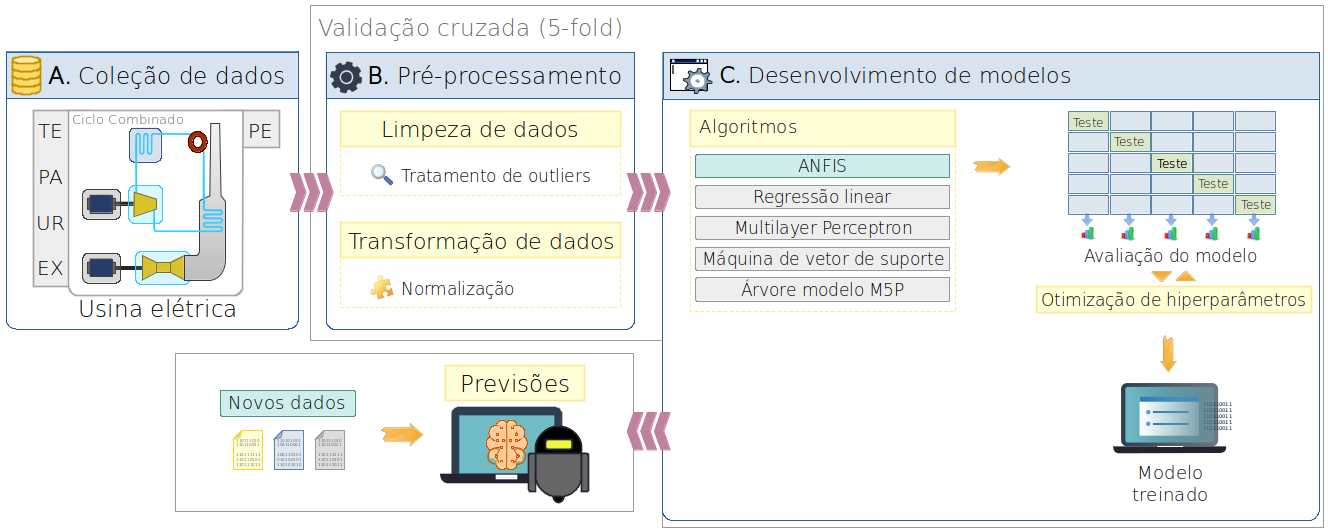Comparison of adaptive neuro-fuzzy inference system (ANFIS) and machine learning algorithms for electricity production forecasting
Keywords:
Electricity, Power generation, Fuzzy neural networks, Machine learning, Predictive modelsAbstract
Combined cycle power plants (CCPP) are popular in the energy sector for the production of electricity, and are the union of two thermodynamic cycles, corresponding to the steam turbine and the gas turbine. This paper presents the application of several machine learning (ML) techniques and the adaptive neuro-fuzzy inference system (ANFIS) to predict the hourly electricity production in a CCPP. The models were developed using 5-fold cross-validation with the collected features of temperature, exhaust pressure, relative humidity, ambient pressure, and electricity production per hour (the target feature). The hyperparameters of the tested models were optimized. The correlation and determination coefficients of the models were higher than 92%, showing a significant performance. The ANFIS (r = 98% e R2 = 95%) model shows the lowest values in the evaluated error metrics, compared to the other ML models. Finally, the results showed the effectiveness of ANFIS in predicting the hourly production of electricity in CCPP.
Downloads
References
M. Karacor, A. Uysal, H. Mamur, G. Sen, M. Nil, M. Z. Bilgin, H. DoGan, and C. Sahin, “Life performance prediction of natural gas combined cycle power plant with intelligent algorithms,” Sustainable Energy Technologies and Assessments, vol. 47, p. 101398, 2021.
J. M. Alemany, D. Moitre, and F. Magnago, “Power system reliability considering combined cycle plants,” IEEE Latin America Transactions, vol. 8, no. 5, pp. 547–556, 2010.
J. Kotowicz and M. Brzeczek, “Analysis of increasing efficiency of modern combined cycle power plant: A case study,” Energy, vol. 153, pp. 90–99, 2018.
W. Dong, Q. Yang, and X. Fang, “Multi-step ahead wind power generation prediction based on hybrid machine learning techniques,” Energies, vol. 11, no. 8, 2018
P. Tüfekci, “Prediction of full load electrical power output of a base load operated combined cycle power plant using machine learning methods,” International Journal of Electrical Power and Energy Systems, vol. 60, pp. 126–140, 2014.
C. M. Ezhilarasu and I. K. Jennions, “A system-level failure propagation detectability using anfis for an aircraft electrical power system,” Applied Sciences, vol. 10, no. 8, 2020.
S. Marsland, Machine Learning: An Algorithmic Perspective. 6000 Broken Sound Parkway NW, Suite 300, Boca Raton: Taylor and Francis Group, LLC, 2015.
R. Bali, D. Sarkar, B. Lantz, and C. Lesmeister, R: Unleash Machine Learning Techniques. 35 Livery Street, Birmingham B3 2PB,UK: Packt Publishing, Ltd, 2016.
A. Arango and J. Velásquez, “Forecasting the colombian exchange market index (igbc) using neural networks,” Latin America Transactions, IEEE (Revista IEEE America Latina), vol. 12, pp. 718–724, 06 2014.
M. M. Suarez-Alvarez, D.-T. Pham, M. Y. Prostov, and Y. I. Prostov, “Statistical approach to normalization of feature vectors and clustering of mixed datasets,” Proceedings of the Royal Society A: Mathematical, Physical and Engineering Sciences, vol. 468, no. 2145, pp. 2630–2651, 2012.
L. K. Moayedi, Hossein ADN Foong and H. Nguyen, “Soft computing method for predicting pressure drop reduction in crude oil pipelines based on machine learning methods,” Journal of the Brazilian Society of Mechanical Sciences and Engineering, vol. 42, no. 11, 2020.
A. Etemad-Shahidi and M. Taghipour, “Predicting longitudinal dispersion coefficient in natural streams using m5p model tree,” Journal of Hydraulic Engineering, vol. 138, no. 6, pp. 542–554, 2012.
M. Nait Amar and N. Zeraibi, “Application of hybrid support vector regression artificial bee colony for prediction of mmp in co2-eor process,” Petroleum, vol. 6, no. 4, pp. 415–422, 2020.
B. Kaczorowski, M. Kleina, M. Augusto Mendes Marques, and W. de Assis Silva, “Artificial intelligence and the multivariate approach in predictive analysis of the small cap index of the brazilian stock exchange,” IEEE Latin America Transactions, vol. 19, no. 11, pp. 1924–1932, 2021.
E. Alpaydin, Introduction to Machine Learning. Cambridge, Massachusetts, London, England: The MIT Press, 2004.
D. S. Prashanth, R. V. K. Mehta, and N. Sharma, “Classification of handwritten devanagari number – an analysis of pattern recognition tool using neural network and cnn,” Procedia Computer Science, vol. 167, pp. 2445–2457, 2020.
R. May, H. Maier, and G. Dandy, “Data splitting for artificial neural networks using som-based stratified sampling,” Neural networks : the official journal of the International Neural Network Society, vol. 23, pp. 283–94, 11 2009.


